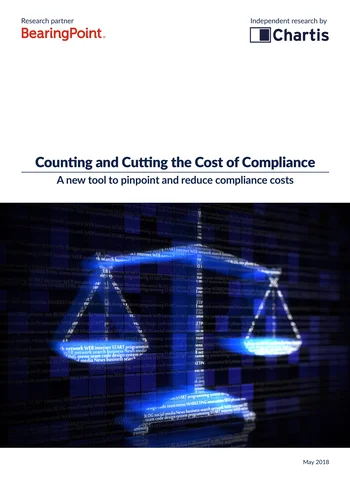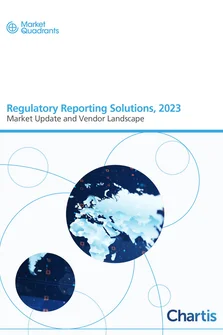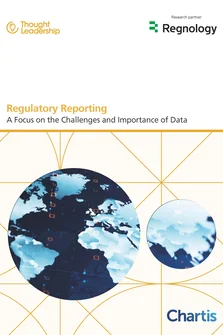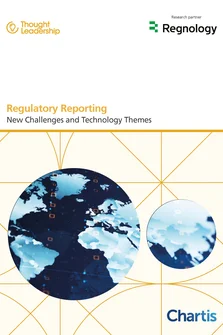<div class="WordSection1">
<p class="MsoBodyText">Financial Institutions (FIs) exist in a challenging environment. Following the last financial crisis, multiple waves of new national and supranational regulation have constricted FIs’ profits through, for example, the imposition of minimum capital requirements. Simultaneously, they have driven up general compliance expenditure. And, as regulations have continued to proliferate, most firms acknowledge that it is not enough merely to comply with current regulations – they must budget for future ones too.</p>
<p class="MsoBodyText">Against this backdrop, attitudes to compliance spending within FIs are changing. The sheer necessity of compliance pushed many FIs to adopt a ‘blank check’ approach – spending what had to be spent to stay within the law and avoid weighty fines. However, with the global regulatory push showing no sign of relenting soon, compliance costs must be controlled.</p>
<p class="MsoBodyText">For FIs, a big part of the answer lies in being able to pinpoint exactly where their compliance costs sit, across the technology, processes and operations that absorb this expenditure. Going forward, high- performing firms will demonstrate an ability to manipulate the right organizational ‘gears’ or ‘levers’ to optimize their total cost of compliance, taking a vital step toward achieving efficient compliance and reducing overall expenditure.</p>
<p class="MsoBodyText">A thorough review of the available literature in this space revealed many limitations. We found that many of the models designed to help FIs tackle these issues are limited in three critical ways:</p>
<ul>
<li>Firstly, many tend to be <strong>too descriptive in their approach</strong>, lacking meaningful actionable insight, and correlating an overall cost of compliance with an external variable (such as a specific regulation). In the absence of targeted use cases, analysis remains academic at best, and difficult for decision makers to translate into action.</li>
<li> <!--[endif]-->Where recommendations are offered, they also tend to be linked to organizational characteristics – such as size – which in reality are <strong>extremely difficult to implement </strong>without major institutional transformation.</li>
<li> <!--[endif]-->And, where it is offered, <strong>advice tends to be too broad</strong>, neglecting to take into account granular ‘nuts and bolts’ issues that exist within FIs, such as the question of data centralization versus localization and the nature and impact of Application Programming Interfaces (APIs) and feed handlers. Rather, they call instead for sweeping changes at divisional levels, or tweaks to more nebulous factors such as corporate culture.</li>
</ul>
<p class="MsoBodyText">To address these challenges, Chartis Research, in collaboration with our research partner BearingPoint, has developed a focused cost-attribution model that FIs can use as a diagnostic tool to benchmark their Risk Data, Aggregation and Regulatory Reporting (RDAR) processes and ‘levers’ against those of peer institutions. RDAR, we believe, represents the largest block of compliance expenditure within FIs, presenting a solid target for our study to address, and helping us bring focus to our study.</p>
<p class="MsoBodyText">In the context of RDAR expenditure, we drew a range of important conclusions, including:</p>
<ul>
<li><strong>Choosing the right operational structure for compliance is critical </strong>– narrow, regional reporting platforms deliver lower core spending overall than global reporting platforms, but at a much higher residual cost, and higher compliance costs overall. Integrated platforms delivered the lowest overall cost by some margin.</li>
<li><strong>Demand is growing for utilities</strong>, driven by the relentless need to reduce cost, particularly in peripheral processes – such as capital markets reports for small regional banks – and non-core regions for large international banks. As a result, banks will be able to achieve better optimized trade-offs between key operational concerns (e.g. centralization vs. localization) at a lower cost.</li>
<li>In all scenarios, <strong>complexity emerged as a major determining factor of cost </strong>– asset managers and investment banks, utilizing simpler, more centralized reporting platforms, fared much better than retail banks, as did those with a smaller geographical footprint. For large, universal banks, the benefits of a fully integrated solution over narrow, regional compliance centers will be material.</li>
</ul>
</div>
<p class="MsoBodyText">This sample of headline results highlights just some of the key drivers of compliance cost uncovered by our model, and some of the key considerations for FIs to tackle as they seek to achieve enhanced</p>
<p class="MsoBodyText">cost efficiency. However, beyond these findings, our model has allowed us to isolate specific levers and drivers of cost reduction (and cost intensity), effectively showing which levers can be pulled to what effect. In terms of turning theory into action, this is the crucial next step.</p>
<table>
<tbody>
<tr>
<td>
<p class="MsoNormal"><em>‘To cut costs you need an accurate view of what they are.’ Representative of a US-based global bank</em></p>
</td>
</tr>
</tbody>
</table>
<p>As described later in this document, we settled on five key organizational levers and the areas of cost impact controlled by each. Of the five, three emerged as being crucial drivers of cost:</p>
<ul>
<li><strong>Centralization of data storage.</strong></li>
<li><strong>Uniformity of the feed handler environment.</strong></li>
<li><strong>Availability of APIs.</strong></li>
</ul>
<p class="MsoBodyText">So, while FIs using integrated platforms for data management have lower overall compliance spending, less efficient regional spenders could still make significant cost gains through the use of APIs, spending significantly less on data input, enrichment and distribution than those without them. The efficient use of feed handlers simply magnifies this positive effect.</p>
<p class="MsoBodyText">This report, which should be read in conjunction with our position paper<sup>1</sup>, outlines the key issues facing the industry in RDAR cost compliance, details a robust methodology designed to highlight the core trends and ‘levers’ governing RDAR compliance costs, and offers clear, actionable insight to readers tackling a critically important challenge. In creating this report, we also hope to have added something new to the debate around compliance cost, and would welcome the opportunity to discuss our findings with you.</p>
<p class="MsoNormal"><em>[1] </em><em><a href="https://www.chartis-research.com/other/regulatory-compliance-reporting/… and Cutting the Cost of Compliance: How to accurately assess the cost of Risk Data Aggregation and Regulatory Reporting</a>.</em></p>
Only users who have a paid subscription or are part of a corporate subscription are able to print or copy content.
To access these options, along with all other subscription benefits, please contact info@risk.net or view our subscription options here: http://subscriptions.risk.net/subscribe
You are currently unable to print this content. Please contact info@chartis-research.com to find out more.
You are currently unable to copy this content. Please contact info@chartis-research.com to find out more.
Copyright Infopro Digital Limited. All rights reserved.
You may share this content using our article tools. Printing this content is for the sole use of the Authorised User (named subscriber), as outlined in our terms and conditions - https://www.infopro-insight.com/terms-conditions/insight-subscriptions/
If you would like to purchase additional rights please email info@chartis-research.com
Copyright Infopro Digital Limited. All rights reserved.
You may share this content using our article tools. Copying this content is for the sole use of the Authorised User (named subscriber), as outlined in our terms and conditions - https://www.infopro-insight.com/terms-conditions/insight-subscriptions/
If you would like to purchase additional rights please email info@chartis-research.com



